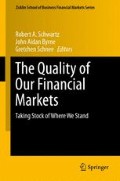Abstract
ROBERT SCHWARTZ: It is my pleasure to introduce our moderator, Marcus Hooper. I can’t think of another moderator or speaker here today I have had more beers with than Marcus. (Laughter)
Access this chapter
Tax calculation will be finalised at checkout
Purchases are for personal use only
Notes
- 1.
Instinet, launched in 1967 as Institutional Networks Corp. and offering trading in anonymity for institutional investors, is regarded as an early and ground-breaking electronic pioneer.
- 2.
This crossing network was created in 2005 with Ross as a founding partner. It was sold to the NYSE and launched as NYSE MatchPoint in 2006 with Ross joining as vice president of the business.
- 3.
Latency measures the length of time to execute a trade from order entry to execution. The speaker is referring to the ability of market participants to gain advantages in speed of trade execution through advanced technology, specifically the “co-location” of their computer servers near stock exchanges. Lower latency is generally driven in proportion to the nearness of the servers to the exchanges.
- 4.
The Financial Information Exchange (FIX) protocol is the messaging standard for pre-trade and trade communication in the global equity markets.
- 5.
The Dodd–Frank Wall Street Reform and Consumer Protection Act (Dodd-Franks) was signed into law by President Obama on July 21, 2010.
- 6.
NASDAQ market makers were accused in the late 1980s of abusing their privileges by not providing liquidity and two-sided continuous quotes at the time of the 1987 market crash. That led to the introduction of the Small Order Execution System (SOES). More significantly, these same market makers were also accused of colluding to keep bid ask spreads on stock prices artificially wide, a practice characterized by only quoting stocks in even one eight increments (i.e., 0, 2/8, 4/8, 6/8).
- 7.
Schack said in a follow-up interview that investors would be willing to quote Citi in increments of less than a penny if the minimum increment was lowered from a penny.
- 8.
Small Order Execution System introduced in response to the 1987 Crash. Market makers attracted criticism for not “picking up their phones” to take customer orders.
- 9.
The International Securities Association for Institutional Trade Communication (ISITC) was founded in 1991 by financial industry leaders and competitors who saw the benefit of facilitating straight-through processing (STP) among custodian banks, investment manager, and broker dealers. Source: ISITC Website, http://www.isitc.org/history.cfm.
- 10.
The Committee of European Securities Regulators. It is an independent EU Authority in the securities markets.
- 11.
Mako Global Derivatives is part of London-based Mako Group operating since 1999 and active in the equity, fixed income and commodity options markets.
- 12.
Ken Griffin is the American hedge fund manager. He is the founder and CEO of Citadel LLC, a Chicago-based investment firm launched in 1990.
- 13.
Keith Ross is CEO of alternative trading system PDQ Enterprises.
- 14.
Rick (Richard) Ketchum, Chairman & CEO, FINRA, discussed this in his testimony before the Subcommittee on Securities, Insurance, and Investment Committee on Banking, Housing, and Urban Affairs United States Senate, May 20, 2010. See, http://www.finra.org/Newsroom/Speeches/Ketchum/P121509
- 15.
For background, see, Findings Regarding The Market Events of May 6, 2010. Report of the Staffs of the CFTC and SEC to the Joint Advisory Committee on Emerging Regulatory Issue, http://www.sec.gov/news/studies/2010/marketevents-report.pdf
- 16.
The “fat finger” refers to human mechanical error in entering a trade via key strokes. The error in this instance could be 75,000 rather than 75. The “fat finger” would have clumsily typed in three unintended zeroes.
- 17.
In 2010, Jerome Kerviel was found guilty of a €4.9bn trading loss at Societe Generale.
- 18.
This refers to the trading pause mechanism in the Liquidity Replenishment Points (LRPs) program operated by the New York Stock Exchange.
- 19.
In its report on the Flash Crash, the CFTC and SEC report noted a skittish market environment prior to the Crash because of concern about European sovereign debt. However, the report cited a single sell order of 75,000 S&P E-mini contracts traded at the Chicago Mercantile Exchange as the catalyst for the Crash. Media reports cited the mutual fund Waddell & Reed in Kansas as the source of that sell order, which was valued at approximately $4.1 billion.
See, Kansas mutual fund at center of flash crash, Nelson D. Schwartz, New York Times, May 15, 2010. http://www.sfgate.com/business/article/Kansas-mutual-fund-at-center-of-flash-crash-3264771.php
- 20.
Regulation NMS, or National Market System, was enacted by the Securities and Exchange Commission in 2007 to foster competition among US exchanges and individual orders, and to promote fairness in price executions across all exchanges and platforms.
- 21.
The International Organization of Securities Commissions. See Website, http://www.iosco.org/about/
- 22.
Stub quotes are bids for stocks near zero. For example, 22.01 bid for a stock trading at $25.00.
- 23.
MiFID, the Markets in Financial Instruments Directive was enacted as European Union law on November 1, 2007 to foster competition and investor protection. It harmonizes the regulation of financial services among EU member nations.
- 24.
See, Extra: How High Frequency Trading Grew. 60 Minutes, CBS News www.cbsnews.com/video/watch/?id=6945166n
- 25.
For background, see, Avoiding the next big financial crisis, Jennifer Liberto, CNNMoney, June 8, 2009, http://money.cnn.com/2009/06/05/news/economy/financial_regulation/index.htm
- 26.
In June 2011, Bill Harts joined Thomson Reuters Markets as Chief Strategy Officer for Sales & Trading.
Author information
Authors and Affiliations
Editor information
Editors and Affiliations
Rights and permissions
Copyright information
© 2013 Springer Science+Business Media New York
About this paper
Cite this paper
Hooper, M. et al. (2013). New Technology: What Does It Bring to the Table?. In: Schwartz, R., Byrne, J., Schnee, G. (eds) The Quality of Our Financial Markets. Zicklin School of Business Financial Markets Series. Springer, New York, NY. https://doi.org/10.1007/978-1-4614-5592-9_5
Download citation
DOI: https://doi.org/10.1007/978-1-4614-5592-9_5
Published:
Publisher Name: Springer, New York, NY
Print ISBN: 978-1-4614-5591-2
Online ISBN: 978-1-4614-5592-9
eBook Packages: Business and EconomicsBusiness and Management (R0)

